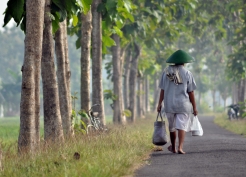
Green Bonds have been mentioned a number of times at the Forests Asia Summit taking place this week in Jakarta as a mechanism to finance sustainable land use and were described in excited terms at the Abu Dhabi UN Ascent in advance of this year’s UN Climate Summit. What is all the excitement about? Finance experts Iain Henderson and Johan Kieft, in Jakarta for the Forests Asia Summit; and Sean Kidney, at the Abu Dhabi UN Ascent, have not only asked a few questions, but tried to answer them too!
Q: There has been a lot of interest in bonds at the Forests Asia Summit in Jakarta this week. Are they a new financial mechanism?
A: The short answer is no. In fact, they have been around for hundreds of years and we know they were used in Renaissance Italy about 800 years ago. There are even claims that – like many things – the Romans invented them a couple of thousand years ago during the time of the Roman Republic.
Q: So why all the interest?
A: There are a few reasons. Although bonds aren’t a new mechanism, green bonds are relatively new and interest in them from the world’s largest investors is growing rapidly. We are also seeing the range of issuers expand and corporates are also now using green bonds to raise funds to drive sustainability down their supply chains. High quality or “investment grade” bonds are also the single largest pool of private sector capital. This is relevant as it is increasingly clear that we need to tap into the vast pools of private sector resources to plug the well-documented finance gap. Creating a financing mechanism that looks, smells and feels like something private investors buy and sell in large volumes every day makes a lot of sense.
Q: Fine, but why is this relevant to REDD+?
A: There is growing recognition that we need to move away from a “siloed” forest-centric approach to deforestation and forest degradation, towards a more holistic approach to development that is forest-friendly and has green growth at its heart. Beyond the forest frontier, we will also need to deal with the agricultural, infrastructure, urban and transport requirements that are essential to creating a green economy and this all costs money. However, this green economic transformation is vital to create the jobs and green growth that will in turn create the social and political space to allow REDD+ to be implemented at scale.
Q: So, how do bonds fit into this scenario?
A: To create the green economy described above, we will need a blueprint, and for this we need carefully planned green growth strategies that include REDD+. These blueprints will in turn require financing. This is where green bonds come in, as they are a mechanism for preferencing these sorts of green productive investments over alternative growth strategies in developing economies.
Q: How do the investors know what is “green”?
A: We need credible standards to differentiate what is green and what is not, especially in complicated areas like forestry and agriculture. These standards then need to be verified by reliable external third parties to make sure the funds raised from the bonds are helping, and not hindering, green development.
Q: Will this make a difference?
A: Yes. Robust standards that are externally validated can help reduce the risk and complexity of greener investing. They make product selection simple and standardised for investors and they outsource the social and environmental due diligence to credible third parties. There is huge demand for this. Twenty two trillion US dollars in assets represented by the Climate Bonds Initiative advisory panel is calling for this to help screen and preference green investment.
Q: Is this just about the private sector?
A: No. This is about repositioning the narrative in both policy and financial circles towards financing productive investments that will provide a much needed long-term economic stimulus. Uncovering the large-scale investor appetite we are seeing in the market will help to spur policy makers to develop green growth frameworks in the knowledge that cheap private sector capital is eager and available.
Q: So how do we scale up?
A: There are several key requirements such as issuing in large size to create the “liquidity” required by the biggest investors, strategic use of public balance sheets to buy down the cost of capital, using tax incentives and creating a compelling story. Have a look here for some more on this.
About the authors:
Iain Henderson joined the United Nations Environment Programme Finance Initiative (UNEP FI) in Geneva in 2012 to work on REDD+ and Sustainable Land Use. Prior to this, he spent two years in Hong Kong, where he grew up, with WWF’s Forest & Climate Initiative working on finance-related issues. For the first 12 years of his working life, Iain worked in investment banks in London in the Fixed Income, Currencies and Commodities divisions of UBS and Deutsche Bank.
Sean Kidney CEO and co-founder of Climate Bonds Initiative is also a member of the Board of the Network of Sustainable Financial Markets. He is also a member of the Commonwealth Expert Group on Climate Finance; the Finance Advisory Board of the European Wind Energy Association; Mercer’s Sustainability Opportunities Fund Advisory Panel; Palmetto’s renewal energy fund advisory board; and the Advisory Council for the Corporate Knights Capital Advisory Council.
Johan Kieft is currently working as the Head of the Green Economy Unit at the United Nations Office for REDD+ Coordination in Indonesia (UNORCID). During his career, Johan focused on climate change, green growing mainstreaming in development planning and sustainable development with a variety of development agencies and the United Nations. Some of his key achievements include his work on humanitarian assistance in Indonesia, facilitating the drafting process of the Viet Nam Green Growth Strategy and developing concept to mainstream REDD+ in a Green Economy in Indonesia. |